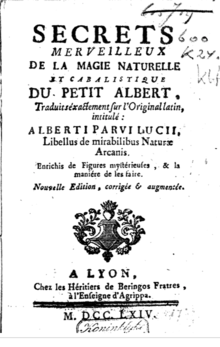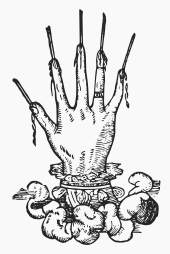Petit Albert
Petit Albert (English: Lesser Albert) is an 18th-century grimoire of natural and cabalistic magic.[4][5] The Petit Albert is possibly inspired by the writings of Albertus Parvus Lucius (the Lesser Albert.)[6][7] Brought down to the smallest hamlets in the saddlebags of peddlers,[3] it represents a phenomenal publishing success, despite its association with "devil worshippers"[8]—or rather thanks to it. It is associated with a second work, the Grand Albert. It is a composite, even heterogeneous work, and perhaps a bric-a-brac, collecting texts of unequal value written by (or attributed to) various authors; most of these authors are anonymous, but some are notable such as Cardano and Paracelsus. It is a relatively old text, in which even the attribution to Albertus Magnus is dubious. Coupled with the fact that it quotes from so many later sources, this makes it an ethnological document of the first order.
 | |
| Author | Albertus Parvus Lucius[1] ("Lesser Albert") |
|---|---|
| Original title | Secrets merveilleux de la magie naturelle et cabalistique du petit Albert. |
| Country | France |
| Language | French |
| Subject | magic |
| Genre | grimoire |
| Publisher | Héritiers de Beringos fratres |
Publication date | circa 1706[2][3] |
Published in English | 2012 (as "The Spellbook of Marie Laveau") |
| Media type | Print (Hardcover) |
| OCLC | 164442497 |
| Preceded by | Grand Albert |
| Followed by | Grand Grimoire (the Red Dragon) |
Grand Albert and the Petit Albert
Under the aegis of the Grand Albert
The Little Albert is generally mentioned at the same time as the Grand Albert, another grimoire. The Little Albert, however, is neither a summary nor an abridged version of the Grand Albert; it is a separate text, as can be seen in a comparison of the two works by Claude Seignolle in a French work titled, Les Évangiles du Diable (in English: The Gospels of the Devil).[9]
The author of these two works, or at least the Grand Albert, is in theory Albertus Magnus, born about 1193, theologian, Sorbonne University professor. "Albertus Magnus" (or, in English, literally, "Albert the Great") was canonized. The Place Maubert (etymologically Place of the "Master Albert") in Paris is named after him. The text of Secrets merveilleux de la magie naturelle et cabalistique du Petit Albert that was published by Chez les Heritiers Beringos in 1752 specifically credits authorship to Alberti Parvi Lucii.[10] In Tarl Warwick's 2016 English translation, the warning to the reader says: "Here is a new edition of the Wonderful Natural Secrets of the Little Albert, known in Latin by the title Libellus Alberti Parvi Lucii of mirabilibus Arcanis naturae: the author was one of those noble and wise men accused of witchery by the ignorant masses; (it was formerly the fate of all the great minds who possessed something extraordinary in science, as they were treated like magicians.)"[8]
The writings of Master Albert were obviously not printed in his day, as he died (in 1280) before the invention of the printing press (circa 1440). The earliest known edition appeared in France in 1706 and was published by "Chez les Heritiers Beringos" in Lyon, which represents a gap of more than 400 years between the estimated date of writing and that of printing, a range of time that opens up many possibilities for the evolution of the text. In fact, the publishing company that printed it was fictional.[3] According to the historian Owen Davies, to publish controversial and even illegal grimoires under the "Chez les Heritiers Beringos" was a common tactic in the 18th and 19th centuries,[3] as grimoires became increasingly censored by the Catholic Church.[11] The location of the publisher was described as being at the "sign of Agrippa."[3][11]
The fact that the Big and the Little Albert are named after Albertus Magnus is a claim that should not be taken literally. In spite of this article's name, it is extremely important to note that the text actually contains references known to be by authors posterior to the Master Albert, like Paracelsus, very largely quoted. Furthermore, there are mentions of events which occurred after the time of the Master Albert. By placing themselves under the aegis of Albert the Great, these works seek recognition and legitimacy. This practice of collective attribution to one great person in history was common practice in the time of the first printing of the Petit Albert. It is not comparable to modern falsification or plagiarism. Far from it, and far from any motive of willful deceit, it was regarded as a way to pay homage while also giving cover to the writers of controversial topics.
From 1850, the Grand and the Petit Albert are published under the following titles:
- Le Grand Albert et ses secrets merveilleux (the Grand Albert)
- Les secrets mystiques de la magie naturelle du Petit Albert
- Le Dragon Rouge (also known as the Grand Grimoire)
These three works were collected in a grand three-volume work published in Paris in the 1860s, entitled Le Grande et Veritable Science Cabalistique.[1]
Reactions of the Church
The reaction of the Catholic Church in the 19th and early 20th centuries was negative. The Church held that the combination of the two "Alberts" was itself a form of black magic. So those who read them, did so in secret, hid them under a beam in the attic, and sometimes wondered which of the neighbors could own a copy.
Even some of those who were good Christians tried to bless the book in secret by hiding it under the tablecloth of the altar.[11] Priests knew about this practice. They inspected the possible hiding places before mass and made the "Albert" disappear if they found one. Legends about the Albert flourished. It was said that the devil tries to take back his books and that destroying an Albert was too dangerous for an individual to accomplish safely. With the goals of safety and salvation in mind, the presence of an Albert should be confided to a priest.
The attitude of the Church after the French Revolution contrasts with the fact that the book had a long editorial life by no means clandestine since successive editions were published in Lyon under the Ancien Régime, and even before the Age of Enlightenment, when the Church had every latitude to ban it.
The book was indirectly censored from 1793 to 1815 when peddling literature was prohibited; evidently the Church was not involved in this decision.
Editorial phenomenon
The two Alberts, sold by peddling[3] and inseparable from the Almanac (with astrological calendar, another great success of the popular edition)[11] made the fortune of their publishers, since, according to Seignolle, it sold 400,000 a year in the Belgian Ardennes alone.[9] This means that everyone had one, even if everyone pretended to be indignant at the existence of these books.
The profile of the reader was not that of the sorcerer, but that of a man of the world, who at the time was a farmer, and who was in general deeply Christian.
This success is all the more remarkable because these books were of no use to the peasant. The formulas were not very practical. Even the cooking recipes (different compositions of spicy wine) require many expensive ingredients, difficult to identify and usually absent from French villages.
The intended audience occupied the whole social spectrum. The hand of glory, for example, was an instrument appreciated by burglars. The soap recipes and the eau de toilette, which include many expensive ingredients from around the world, are probably those of the apothecaries of the ladies of the Court. "Copies of Le Petit Albert have been located among the 19th century French peasantry, the Hoodoo practitioners of New Orleans, and the Obeah men of the French West Indies."[1]
The Petit Albert became a meme. "To say one had the Petit Albert was shorthand for saying one was deep in magic."[3]
Petit Albert
Contents of the book

- A warning to the reader[12]
- Sexual magic (ways to obtain romantic love, seduction, and even to make a woman dance naked)
- Means to improve agricultural efficiency
- Means to avoid various inconveniences (such as menaces who destroy crops or kill chickens)
- Cooking recipes
- Other recipes for daily life, such as "a soap for faces and hands alike"[8]
- Means for people and horses to move quickly and without fatigue
- Making a "hand of glory"
Other parts of the book represent the presentation of alchemical or cabalist theories whose origin is attributed mainly to Paracelsus. These include talismans in accordance with cabalist methods: how to make gold artificially, for example, and how to dissolve gold. Other how to's include how to turn lead into gold, how to create fake money using tin, how to use borax to melt gold, and how to create imitation pearls.[8]
Cultural references
In literature
- Voltaire mentions the Petit Albert in his Dictionnaire philosophique.[13]
References
- Hayes, Kevin (1997). Folklore and Book Culture. Internet Archive. University of Tennessee Press. p. 26. Retrieved 24 February 2019.
Petit Albert in popular culture.
- "The earliest report I have found to a magical text of this name is in d'Argenson's report of 1702...." The earliest known French edition was published in 1706 under the imprint of Beringos Fratres." Owen Davies, Grimoires: A History of Magic Books. Oxford University Press, 2009.
- Davies, Owen (2010). Grimoires: A History of Magic Books. Oxford: OUP. ISBN 9780191509247. Retrieved 24 February 2019.
- Albert, Petit (1782). Secrets merveilleux de la magie naturelle et cabalistique du petit Albert [The Little Albert] (in French). Lyon: Héritiers de Beringos fratres. OCLC 164442497.
- Davies, Owen (2008-04-04). "Owen Davies's top 10 grimoires". The Guardian. Retrieved 2009-04-08.
- https://library.hrmtc.com/tag/albertus-parvus-lucius/
- http://dla.library.upenn.edu/dla/medren/pageturn.html?id=MEDREN_9962936093503681
- Warwick, Tarl; Magnus, Albertus (2016). The Petit Albert: The Marvellous Secrets of the Little Albert: English Edition (Illustrated ed.). ISBN 9781523429790. Retrieved 24 February 2019.
- Claude Seignolle, Les Évangiles du Diable, Paris, Robert Laffont, collection " Bouquins ". The Petit Albert occupies the pages 807–895.
- Parvus Lucius, Albertus (1752). Secrets merveilleux de la magie naturelle et cabalistique du Petit Albert. Complutense University of Madrid: chez les heritiers de Beringos frates. Retrieved 20 March 2019.
- "La Magie naturelle: Grimoires Priaulx Library". 2019-02-24. Archived from the original on 2019-02-24. Retrieved 2019-02-24.
- Rovira, Ashley. "The Petit Albert". Scribd. Retrieved 20 March 2019.
- https://fr.wikisource.org/wiki/Page:Voltaire_-_%C5%92uvres_compl%C3%A8tes_Garnier_tome18.djvu/548